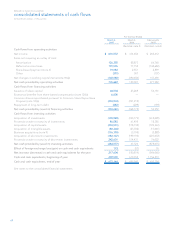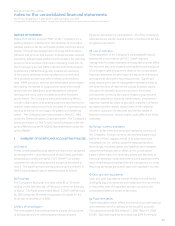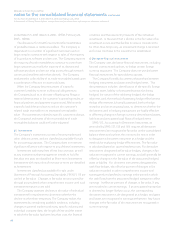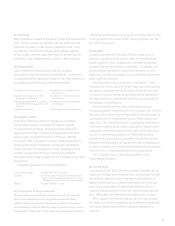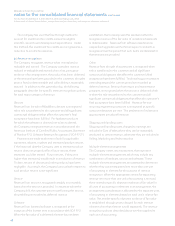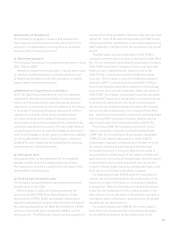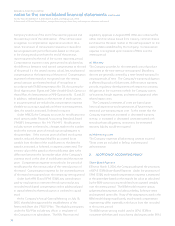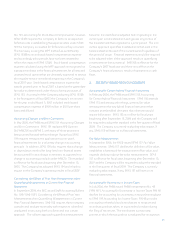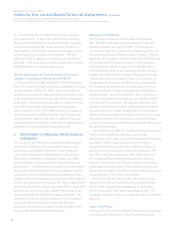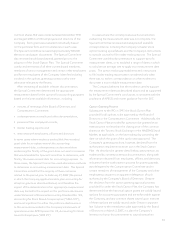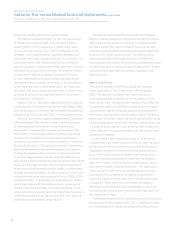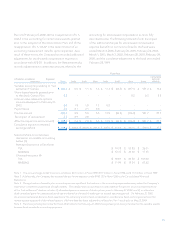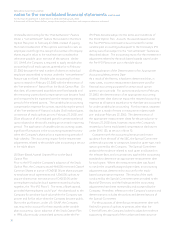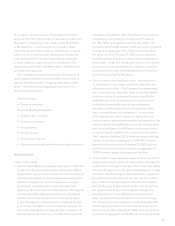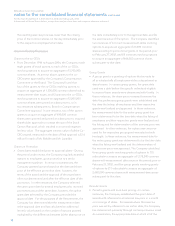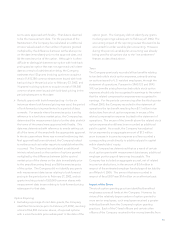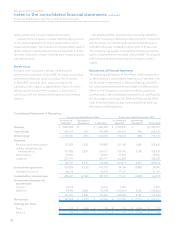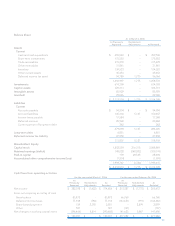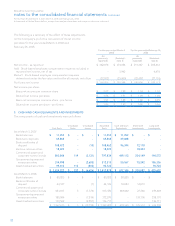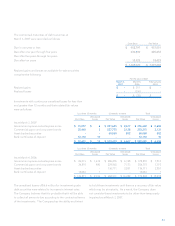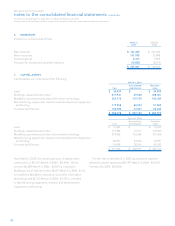Blackberry 2007 Annual Report Download - page 76
Download and view the complete annual report
Please find page 76 of the 2007 Blackberry annual report below. You can navigate through the pages in the report by either clicking on the pages listed below, or by using the keyword search tool below to find specific information within the annual report.74
RESEARCH IN MOTION LIMITED
notes to the consolidated financial statements continued
For the Years Ended March 3, 2007, March 4, 2006 and February 26, 2005
In thousands of United States dollars, except share and per share data, and except as otherwise indicated
options are validly exercised by option holders.
The Review revealed that prior to the commencement
of the Review in August 2006, all stock option grants,
except grants to the Company’s co-CEOs, were made
by or under the authority of co-CEO Jim Balsillie or his
delegate in accordance with an apparent delegation of
such authority by the Company’s Board. For a number of
years after the IPO, Mr. Balsillie was directly involved in
approving grants, including grants that have been found to
have been accounted for incorrectly. Mr. Balsillie’s direct
involvement in approving grants diminished over time,
as more responsibility for approving certain grants was
delegated, without explicit conditions or documentation,
to Mr. Kavelman and to other employees. Mr. Kavelman
and other, less senior, personnel were also involved in the
granting of options that have been found to have been
accounted for incorrectly.
Grants to the co-CEOs were approved by the Company’s
Compensation Committee or the Board. After March 2003,
the Compensation Committee also reviewed compensation
payable to the COOs and the CFO, including option grants.
The 3,231 stock option grants made between December
1996 and August 2006 can be broadly classified as grants
to new employees or to former co-op students who
rejoined the Company after completing university (“New
Hire Grants”), and periodic awards to existing employees
and directors, including grants awarded to employees
following a promotion to a more senior position (“Grants to
Existing Employees”). The Special Committee determined
that some New Hire Grants and the majority of Grants to
Existing Employees used an incorrect measurement date
for accounting purposes, with the result that the exercise
price of the options was less than the fair market value of the
shares as of the date on which the terms and recipients of
those options were ascertained with finality, as determined
through objective evidence. In many instances, including in
connection with some option grants to the co-CEOs, COOs
and the CFO (the “C-level officers”), hindsight was used to
select grant dates with favorable pricing on grants and in
limited instances grant dates were selected based on low
prices over a future period, resulting in grantees receiving an
in-the-money option that was not recorded in the financial
statements as stock-based compensation.
The Special Committee determined that the Company
failed to maintain adequate internal and accounting controls
with respect to the issuance of options in compliance with
the Stock Option Plan, both in terms of how options were
granted and documented, and the measurement date used
to account for certain option grants. The grant process
was characterized by informality and a lack of definitive
documentation as to when the accounting measurement date
for a stock option occurred, and lacked safeguards to ensure
compliance with applicable accounting, regulatory and
disclosure rules.
Nature of the Errors
The period covered by the Review spans the inception
of the Stock Option Plan in December 1996 to August
2006. The Special Committee also examined certain
stock-based awards granted prior to the adoption of the
Stock Option Plan. As was permitted prior to fiscal 2007, the
Company elected to use APB 25 to measure and recognize
compensation cost for all awards granted to employees for
their service as employees, as discussed in Note 1. APB 25 is
based upon an intrinsic value method of accounting for stock-
based compensation. Under this method, compensation cost
is measured as the excess, if any, of the quoted market price
of the stock at the measurement date over the amount to be
paid by the employee.
Under APB 25, the measurement date for determining
compensation cost of stock options is the first date on which
are known both (1) the number of shares that an individual
employee is entitled to receive and (2) the option exercise
price. If either the number of shares or the exercise price
(or both) of a particular award are not known on the grant
date, the Company must remeasure compensation cost at
each reporting date until both are known. The application
of this principle is referred to as variable plan accounting,
and requires the Company to remeasure compensation
cost at the award’s intrinsic value until a measurement date
is triggered. When both terms are known, the award is
referred to as a fixed award, and compensation cost is not
remeasured for any changes in intrinsic value subsequent to
the measurement date.
The Review identified three significant types of accounting
errors being: (1) the misapplication of U.S. GAAP as it relates
to a “net settlement” feature contained in the Stock Option


